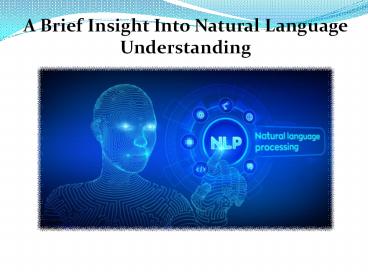A Brief Insight Into Natural Language Understanding - PowerPoint PPT Presentation
Title:
A Brief Insight Into Natural Language Understanding
Description:
Natural Language Understanding is an AI that helps humans to interact with computers using natural language. The use of NLU in computers has come a long way, with many systems using these tools to provide a better user interface for humans. – PowerPoint PPT presentation
Number of Views:198
Title: A Brief Insight Into Natural Language Understanding
1
A Brief Insight Into Natural Language
Understanding
2
Natural Language Understanding is an AI that
helps humans to interact with computers using
natural language. The use of NLU in computers has
come a long way, with many systems using these
tools to provide a better user interface for
humans. Communication with computers and their
aided devices has come a long way. From textual
command inputs via keyboards and mouse to voice
and touch inputs found in the majority of mobile
devices and desktops today, the way we interact
with the computer has changed drastically. The
latest advancements have also paved the way for
more exciting avenues in UI, including brain
mapping, gesture mapping, augmented reality, etc.
And one such advancement is NLU (Natural Language
Understanding). 1. What is Natural Language
Understanding?
3
How would it be if we could simply communicate
with the computer as we would communicate with a
normal person? Natural language understanding
aims to achieve that. This artificial
intelligence (AI) interprets any kind of text or
unstructured data with the help of appropriate
computer software. This means NLU can help
interpret a text or data to computer language and
then translate the output from the computer to a
language that humans can understand easily.
4
While this may sound normal, the difference lies
in the way humans get to interact with the
computer. For instance, while you would have been
forced to use structured sentences to communicate
with the computer before, you can interact with
computers using natural sentences with the help
of NLU. 2. Difference Between Natural Language
Understanding and Natural Language Processing
5
People tend to confuse NLU with Natural language
processing (NLP). NLU does belong to a part of
NLP and can be considered as a subset of the
latter when it comes to the part of understanding
and comprehending user language. The difference
lies in the fact that NLU aims to interpret the
meaning of sentences communicated by the user
rather than sentences themselves. It plays the
part of distinguishing between phrasings,
vocabularies, mispronunciations, etc. to capture
the essence of the sentence. It does this by
making use of several processes like sentiment
analysis, text categorization, content analysis,
etc. to help the computer understand different
inputs. NLP differs from NLU in the fact that it
encompasses the entire process of transforming
unstructured data into the structured one. It
helps users communicate with technology or
establish a natural human conversation with the
same to answer questions or accomplish tasks. 3.
Examples of Natural Language Understanding
6
Here are a few examples of the applications of
Natural Language Understanding in todays
world. Machine Translation One of the hardest
challenges of NLU is the translation of speech or
text from one language to different languages.
However, several game-changers like Microsoft
Translator, Google Translator, Facebook
Translation, etc. have made use of NLUs
algorithms utilizing AI machine training tools
and linguistic rules to create state-of-the-art
generic language translation tools.These machine
translation tools allow you to simply type any
text or upload an entire document to translate
them to several languages. Tools like Google
Translate take things a step ahead by extracting,
reading and translating text from images using
OCR (optical character recognition)
software. Automated Reasoning NLU helps
machines adopt automated reasoning tactics to
provide logical inferences and conclusions. It
allows these machines to provide facts based on
deductions via reasoning and logic using
IF-THEN and similar rules.Take the medical
field for example. A computer can be programmed
to make use of IF-THEN rules to derive
conclusions and diagnoses for medical cases based
on previous diagnoses inferred for similar cases.
7
Speech Recognition Speech recognition is a part
of NLP, which makes use of NLU tools to aid
computers in understanding natural language
speech. It helps humans interact with computers
using natural sentences, with the computer using
NLU algorithms and tools to decipher the meaning
of the sentences and respond accordingly.For
example, instead of asking Google Assistant a
question like Weather Today, you can naturally
ask the question, Whats the weather outside
today? NLU will split the sentence into
different parts and group each part under a
different topic like the date (today), topic
(weather), etc. It would then proceed to provide
the most accurate answer from an online database
of natural language documents like reference
texts, web pages, online news reports,
etc. Language Translation Language translation
is a headache when it comes to understanding the
flow of sentences in different languages. It is
hard to opt for straight translation of languages
from one form to another, as the order of words
in a sentence would not be the same for every
language, meaning the translation tool would have
to restructure the sentence while translating it
from one language to another.
8
While translation tools used to overlook this
fact, the newer translation tools use NLU to
translate languages accurately with a few or no
grammatical errors. This can be a boon when it
comes to communicating with individuals in
different languages. The newer NLU tools also
translate inputted text to different languages,
altering the structure of the sentence
accordingly as well. Article Resource-https//ww
w.eligocs.com/nlu/a-brief-insight-into-natural-lan
guage-understanding/































